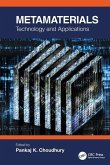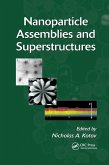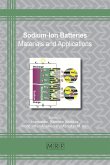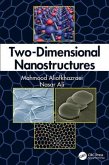Advanced Technologies for Rechargeable Batteries
Two Volume Set
Herausgeber: Das, Akhila; Raghavan, Prasanth; Fatima M. J, Jabeen
Schade – dieser Artikel ist leider ausverkauft. Sobald wir wissen, ob und wann der Artikel wieder verfügbar ist, informieren wir Sie an dieser Stelle.
Advanced Technologies for Rechargeable Batteries
Two Volume Set
Herausgeber: Das, Akhila; Raghavan, Prasanth; Fatima M. J, Jabeen
- Broschiertes Buch
- Merkliste
- Auf die Merkliste
- Bewerten Bewerten
- Teilen
- Produkt teilen
- Produkterinnerung
- Produkterinnerung
The main aim of this volume series is to deliver the significance of latest rechargeable batteries over the currently using lithium-ion batteries. It highlights emerging energy electrochemical systems and the recent progress in energy storage devices.
Andere Kunden interessierten sich auch für
![Ion Exchange and Solvent Extraction Ion Exchange and Solvent Extraction]() Ion Exchange and Solvent Extraction90,99 €
Ion Exchange and Solvent Extraction90,99 €![Multinary Alloys Based on III-V Semiconductors Multinary Alloys Based on III-V Semiconductors]() Vasyl TomashykMultinary Alloys Based on III-V Semiconductors65,99 €
Vasyl TomashykMultinary Alloys Based on III-V Semiconductors65,99 €![Lithium-ion Batteries Lithium-ion Batteries]() Lithium-ion Batteries106,99 €
Lithium-ion Batteries106,99 €![Metamaterials Metamaterials]() Metamaterials68,99 €
Metamaterials68,99 €![Nanoparticle Assemblies and Superstructures Nanoparticle Assemblies and Superstructures]() Nanoparticle Assemblies and Superstructures62,99 €
Nanoparticle Assemblies and Superstructures62,99 €![Sodium-Ion Batteries Sodium-Ion Batteries]() InamuddinSodium-Ion Batteries138,99 €
InamuddinSodium-Ion Batteries138,99 €![Two-Dimensional Nanostructures Two-Dimensional Nanostructures]() Mahmood AliofkhazraeiTwo-Dimensional Nanostructures132,99 €
Mahmood AliofkhazraeiTwo-Dimensional Nanostructures132,99 €-
-
-
The main aim of this volume series is to deliver the significance of latest rechargeable batteries over the currently using lithium-ion batteries. It highlights emerging energy electrochemical systems and the recent progress in energy storage devices.
Produktdetails
- Produktdetails
- Verlag: Taylor & Francis Ltd
- Seitenzahl: 816
- Erscheinungstermin: 20. August 2024
- Englisch
- Abmessung: 254mm x 178mm
- Gewicht: 453g
- ISBN-13: 9781032381817
- ISBN-10: 1032381817
- Artikelnr.: 70148846
- Verlag: Taylor & Francis Ltd
- Seitenzahl: 816
- Erscheinungstermin: 20. August 2024
- Englisch
- Abmessung: 254mm x 178mm
- Gewicht: 453g
- ISBN-13: 9781032381817
- ISBN-10: 1032381817
- Artikelnr.: 70148846
Prasanth Raghavan is a Professor, at Materials Science and NanoEngineering Lab (MSNE-Lab), Department of Polymer Science and Rubber Technology, Cochin University of Science and Technology (CUSAT), Visiting Professor at Biorefining and Advanced Materials Research Center, SRUC (Scotland's Rural College), Edinburgh EH9 3JG, UK and at Department of Materials Engineering and Convergence Technology, Gyeongsang National University, Republic of Korea. Akhila Das is a graduate student pursuing Ph.D. at Materials Science and NanoEngineering Lab (MSNE-Lab), Department of Polymer Science and Rubber Technology (PSRT), Cochin University of Science and Technology (CUSAT), India. Jabeen Fatima M. J has recently joined Carborundum Universal Limited as Manager of Technology. She was previously engaged as a research scientist at Materials Science and NanoEngineering Lab (MSNE-Lab), Department of Polymer Science and Rubber Technology (PSRT), Cochin University of Science and Technology (CUSAT), India. Before joining MSNE Lab, she was working as a tentative Assistant Professor at Department of NanoScience and Technology, University of Calicut, India.
Advanced Technologies for Rechargeable Batteries: Alkaline Metal Ion, Redox
Flow, and Metal Sulfur Batteries
Chapter 1. Current Rechargeable Batteries: Issues and Challenges. Chapter
2. Ion batteries- An overview. Chapter 3. Magnesium ion batteries - An
Overview. Chapter 4. Potential Anode Materials for Magnesium Ion Batteries.
Chapter 5. Cathode Materials for Rechargeable Magnesium Ion Batteries.
Chapter 6. Electrolytes for storage Magnesium ion batteries: An overview.
Chapter 7. Polymer electrolytes and separators for magnesium ion batteries.
Chapter 8. Electrochemical Mechanisms in Sodium-Ion Batteries. Chapter 9.
Cathodes for Sodium-ion Batteries. Chapter 10. Anode materials for
sodium-ion battery. Chapter 11. Electrolytes for Sodium ion batteries.
Chapter 12. Redox Flow Battery: an overview. Chapter 13. Vanadium Redox
Flow Batteries: Electrode Materials. Chapter 14. Electrolytes for Vanadium
Redox Flow Batteries. Chapter 15. Aqueous Acidic Redox Flow Batteries.
Chapter 16. Lithium Redox Flow Battery. Chapter 17. Sulfurized
Polyacrylonitrile Cathodes for Advanced Lithium-Sulfur Batteries. Chapter
18. An Overview of Magnesium Sulfur Battery: Next Generation Energy Storage
Device. Chapter 19. Metal Sulfur Battery; A promising candidate for next
generation battery. Chapter 20. Electrolyte for Metal Sulfur Batteries
Advanced Technologies for Rechargeable Batteries: Metal-Ion, Hybrid, and
Metal-Air Batteries
Chapter 1. Chloride Ion Batteries. Chapter 2. Potassium-ion batteries:
Recent Trends and Challenges. Chapter 3. Zinc-ion Batteries: Materials to
Mechanism of Energy Storage. Chapter 4. Recent Advances and Trends in
Al-ion Batteries. Chapter 5. Characterization of Electrochemical Behaviour
of All Iron-Ion Batteries for Grid Scale Applications. Chapter 6. Calcium
Ion Batteries. Chapter 7. Nuclear Batteries: An Overview. Chapter 8.
Magnesium - Lithium Hybrid Batteries. Chapter 9. Metal-air Batteries:
Future of Hybrid or Electric Vehicles (HEV or EV). Chapter 10. Lithium-Air
Batteries: Batteries for Emerging Electric or Hybrid Electric Vehicles (EV
or HEV), a focus into general aspects and electrolyte engineering. Chapter
11. Lithium-air batteries: State of the art developments in anode, cathode
and electrocatalyst. Chapter 12. Emerging Magnesium-Air Battery Technology:
Electrolyte and Anodic Materials. Chapter 13. Emerging Magnesium-Air
Battery Technology: Cathodic Materials. Chapter 14. Advancements in
Sodium-Air Batteries: General Electrochemical Mechanisms and Advances.
Chapter 15. Emerging Sodium-Air Batteries: State of the art in Anode
stabilization. Chapter 16. Advancements in Air cathodes in Sodium-Air
Batteries: Cathode Materials. Chapter 17. State of the art in electrolyte
engineering and separator modifications for Sodium-Air Batteries. Chapter
18. Rechargeable Zn-air Battery: Current challenges and opportunities.
Chapter 19. Emerging Cost-efficient Aluminium-Air Battery Technology-Anode
Materials. Chapter 20. Emerging Cost-efficient Aluminium-Air Battery
Technology: Cathode Materials. Chapter 21. Emerging Cost-efficient
Aluminium-Air Battery Technology: Electrolyte Materials
Flow, and Metal Sulfur Batteries
Chapter 1. Current Rechargeable Batteries: Issues and Challenges. Chapter
2. Ion batteries- An overview. Chapter 3. Magnesium ion batteries - An
Overview. Chapter 4. Potential Anode Materials for Magnesium Ion Batteries.
Chapter 5. Cathode Materials for Rechargeable Magnesium Ion Batteries.
Chapter 6. Electrolytes for storage Magnesium ion batteries: An overview.
Chapter 7. Polymer electrolytes and separators for magnesium ion batteries.
Chapter 8. Electrochemical Mechanisms in Sodium-Ion Batteries. Chapter 9.
Cathodes for Sodium-ion Batteries. Chapter 10. Anode materials for
sodium-ion battery. Chapter 11. Electrolytes for Sodium ion batteries.
Chapter 12. Redox Flow Battery: an overview. Chapter 13. Vanadium Redox
Flow Batteries: Electrode Materials. Chapter 14. Electrolytes for Vanadium
Redox Flow Batteries. Chapter 15. Aqueous Acidic Redox Flow Batteries.
Chapter 16. Lithium Redox Flow Battery. Chapter 17. Sulfurized
Polyacrylonitrile Cathodes for Advanced Lithium-Sulfur Batteries. Chapter
18. An Overview of Magnesium Sulfur Battery: Next Generation Energy Storage
Device. Chapter 19. Metal Sulfur Battery; A promising candidate for next
generation battery. Chapter 20. Electrolyte for Metal Sulfur Batteries
Advanced Technologies for Rechargeable Batteries: Metal-Ion, Hybrid, and
Metal-Air Batteries
Chapter 1. Chloride Ion Batteries. Chapter 2. Potassium-ion batteries:
Recent Trends and Challenges. Chapter 3. Zinc-ion Batteries: Materials to
Mechanism of Energy Storage. Chapter 4. Recent Advances and Trends in
Al-ion Batteries. Chapter 5. Characterization of Electrochemical Behaviour
of All Iron-Ion Batteries for Grid Scale Applications. Chapter 6. Calcium
Ion Batteries. Chapter 7. Nuclear Batteries: An Overview. Chapter 8.
Magnesium - Lithium Hybrid Batteries. Chapter 9. Metal-air Batteries:
Future of Hybrid or Electric Vehicles (HEV or EV). Chapter 10. Lithium-Air
Batteries: Batteries for Emerging Electric or Hybrid Electric Vehicles (EV
or HEV), a focus into general aspects and electrolyte engineering. Chapter
11. Lithium-air batteries: State of the art developments in anode, cathode
and electrocatalyst. Chapter 12. Emerging Magnesium-Air Battery Technology:
Electrolyte and Anodic Materials. Chapter 13. Emerging Magnesium-Air
Battery Technology: Cathodic Materials. Chapter 14. Advancements in
Sodium-Air Batteries: General Electrochemical Mechanisms and Advances.
Chapter 15. Emerging Sodium-Air Batteries: State of the art in Anode
stabilization. Chapter 16. Advancements in Air cathodes in Sodium-Air
Batteries: Cathode Materials. Chapter 17. State of the art in electrolyte
engineering and separator modifications for Sodium-Air Batteries. Chapter
18. Rechargeable Zn-air Battery: Current challenges and opportunities.
Chapter 19. Emerging Cost-efficient Aluminium-Air Battery Technology-Anode
Materials. Chapter 20. Emerging Cost-efficient Aluminium-Air Battery
Technology: Cathode Materials. Chapter 21. Emerging Cost-efficient
Aluminium-Air Battery Technology: Electrolyte Materials
Advanced Technologies for Rechargeable Batteries: Alkaline Metal Ion, Redox
Flow, and Metal Sulfur Batteries
Chapter 1. Current Rechargeable Batteries: Issues and Challenges. Chapter
2. Ion batteries- An overview. Chapter 3. Magnesium ion batteries - An
Overview. Chapter 4. Potential Anode Materials for Magnesium Ion Batteries.
Chapter 5. Cathode Materials for Rechargeable Magnesium Ion Batteries.
Chapter 6. Electrolytes for storage Magnesium ion batteries: An overview.
Chapter 7. Polymer electrolytes and separators for magnesium ion batteries.
Chapter 8. Electrochemical Mechanisms in Sodium-Ion Batteries. Chapter 9.
Cathodes for Sodium-ion Batteries. Chapter 10. Anode materials for
sodium-ion battery. Chapter 11. Electrolytes for Sodium ion batteries.
Chapter 12. Redox Flow Battery: an overview. Chapter 13. Vanadium Redox
Flow Batteries: Electrode Materials. Chapter 14. Electrolytes for Vanadium
Redox Flow Batteries. Chapter 15. Aqueous Acidic Redox Flow Batteries.
Chapter 16. Lithium Redox Flow Battery. Chapter 17. Sulfurized
Polyacrylonitrile Cathodes for Advanced Lithium-Sulfur Batteries. Chapter
18. An Overview of Magnesium Sulfur Battery: Next Generation Energy Storage
Device. Chapter 19. Metal Sulfur Battery; A promising candidate for next
generation battery. Chapter 20. Electrolyte for Metal Sulfur Batteries
Advanced Technologies for Rechargeable Batteries: Metal-Ion, Hybrid, and
Metal-Air Batteries
Chapter 1. Chloride Ion Batteries. Chapter 2. Potassium-ion batteries:
Recent Trends and Challenges. Chapter 3. Zinc-ion Batteries: Materials to
Mechanism of Energy Storage. Chapter 4. Recent Advances and Trends in
Al-ion Batteries. Chapter 5. Characterization of Electrochemical Behaviour
of All Iron-Ion Batteries for Grid Scale Applications. Chapter 6. Calcium
Ion Batteries. Chapter 7. Nuclear Batteries: An Overview. Chapter 8.
Magnesium - Lithium Hybrid Batteries. Chapter 9. Metal-air Batteries:
Future of Hybrid or Electric Vehicles (HEV or EV). Chapter 10. Lithium-Air
Batteries: Batteries for Emerging Electric or Hybrid Electric Vehicles (EV
or HEV), a focus into general aspects and electrolyte engineering. Chapter
11. Lithium-air batteries: State of the art developments in anode, cathode
and electrocatalyst. Chapter 12. Emerging Magnesium-Air Battery Technology:
Electrolyte and Anodic Materials. Chapter 13. Emerging Magnesium-Air
Battery Technology: Cathodic Materials. Chapter 14. Advancements in
Sodium-Air Batteries: General Electrochemical Mechanisms and Advances.
Chapter 15. Emerging Sodium-Air Batteries: State of the art in Anode
stabilization. Chapter 16. Advancements in Air cathodes in Sodium-Air
Batteries: Cathode Materials. Chapter 17. State of the art in electrolyte
engineering and separator modifications for Sodium-Air Batteries. Chapter
18. Rechargeable Zn-air Battery: Current challenges and opportunities.
Chapter 19. Emerging Cost-efficient Aluminium-Air Battery Technology-Anode
Materials. Chapter 20. Emerging Cost-efficient Aluminium-Air Battery
Technology: Cathode Materials. Chapter 21. Emerging Cost-efficient
Aluminium-Air Battery Technology: Electrolyte Materials
Flow, and Metal Sulfur Batteries
Chapter 1. Current Rechargeable Batteries: Issues and Challenges. Chapter
2. Ion batteries- An overview. Chapter 3. Magnesium ion batteries - An
Overview. Chapter 4. Potential Anode Materials for Magnesium Ion Batteries.
Chapter 5. Cathode Materials for Rechargeable Magnesium Ion Batteries.
Chapter 6. Electrolytes for storage Magnesium ion batteries: An overview.
Chapter 7. Polymer electrolytes and separators for magnesium ion batteries.
Chapter 8. Electrochemical Mechanisms in Sodium-Ion Batteries. Chapter 9.
Cathodes for Sodium-ion Batteries. Chapter 10. Anode materials for
sodium-ion battery. Chapter 11. Electrolytes for Sodium ion batteries.
Chapter 12. Redox Flow Battery: an overview. Chapter 13. Vanadium Redox
Flow Batteries: Electrode Materials. Chapter 14. Electrolytes for Vanadium
Redox Flow Batteries. Chapter 15. Aqueous Acidic Redox Flow Batteries.
Chapter 16. Lithium Redox Flow Battery. Chapter 17. Sulfurized
Polyacrylonitrile Cathodes for Advanced Lithium-Sulfur Batteries. Chapter
18. An Overview of Magnesium Sulfur Battery: Next Generation Energy Storage
Device. Chapter 19. Metal Sulfur Battery; A promising candidate for next
generation battery. Chapter 20. Electrolyte for Metal Sulfur Batteries
Advanced Technologies for Rechargeable Batteries: Metal-Ion, Hybrid, and
Metal-Air Batteries
Chapter 1. Chloride Ion Batteries. Chapter 2. Potassium-ion batteries:
Recent Trends and Challenges. Chapter 3. Zinc-ion Batteries: Materials to
Mechanism of Energy Storage. Chapter 4. Recent Advances and Trends in
Al-ion Batteries. Chapter 5. Characterization of Electrochemical Behaviour
of All Iron-Ion Batteries for Grid Scale Applications. Chapter 6. Calcium
Ion Batteries. Chapter 7. Nuclear Batteries: An Overview. Chapter 8.
Magnesium - Lithium Hybrid Batteries. Chapter 9. Metal-air Batteries:
Future of Hybrid or Electric Vehicles (HEV or EV). Chapter 10. Lithium-Air
Batteries: Batteries for Emerging Electric or Hybrid Electric Vehicles (EV
or HEV), a focus into general aspects and electrolyte engineering. Chapter
11. Lithium-air batteries: State of the art developments in anode, cathode
and electrocatalyst. Chapter 12. Emerging Magnesium-Air Battery Technology:
Electrolyte and Anodic Materials. Chapter 13. Emerging Magnesium-Air
Battery Technology: Cathodic Materials. Chapter 14. Advancements in
Sodium-Air Batteries: General Electrochemical Mechanisms and Advances.
Chapter 15. Emerging Sodium-Air Batteries: State of the art in Anode
stabilization. Chapter 16. Advancements in Air cathodes in Sodium-Air
Batteries: Cathode Materials. Chapter 17. State of the art in electrolyte
engineering and separator modifications for Sodium-Air Batteries. Chapter
18. Rechargeable Zn-air Battery: Current challenges and opportunities.
Chapter 19. Emerging Cost-efficient Aluminium-Air Battery Technology-Anode
Materials. Chapter 20. Emerging Cost-efficient Aluminium-Air Battery
Technology: Cathode Materials. Chapter 21. Emerging Cost-efficient
Aluminium-Air Battery Technology: Electrolyte Materials







